What Is Fabric Shears: A Simple Guide For Perfect Cuts
Have you ever tried to cut fabric with your everyday kitchen or paper scissors? It can be really tough, right? The edges might look messy, or the fabric pulls and bunches. That’s where fabric shears come in! They are special scissors made just for fabric, and they make cutting smooth and easy.
This guide will simply explain what fabric shears are, why they’re different, and how they help make your sewing projects turn out great. Using the right tools, like good fabric shears, makes a big difference for anyone who sews or crafts with fabric. It makes the work easier and the results better.
Creating beautiful fabric items starts with a perfect cut. And once your amazing creations are ready, if you’re looking to share or sell them, Packlove can help you add that special finishing touch with professional branding.
1. What exactly are fabric shears?
1.1. Simple definition
So, what are fabric shears? Simply put, fabric shears are special scissors designed just for one job: cutting fabric. They are a type of cutting implement (a tool for cutting) made especially for textiles (fabrics). Their entire design is focused on helping you cut fabric cleanly, easily, and accurately. What makes them “special” is their dedication to fabric, which means they have specific design features that regular scissors don’t.
1.2. Their main job
The main job of fabric shears is to cut through different fabric types – like soft cotton, slippery silk, or tough denim – without pulling, snagging (catching on threads), or damaging the material. They make cutting easier and help you get very precise, straight lines, which is super important for your sewing to look good. Unlike regular scissors, they are made to stop the fabric from bunching up or getting chewed edges.
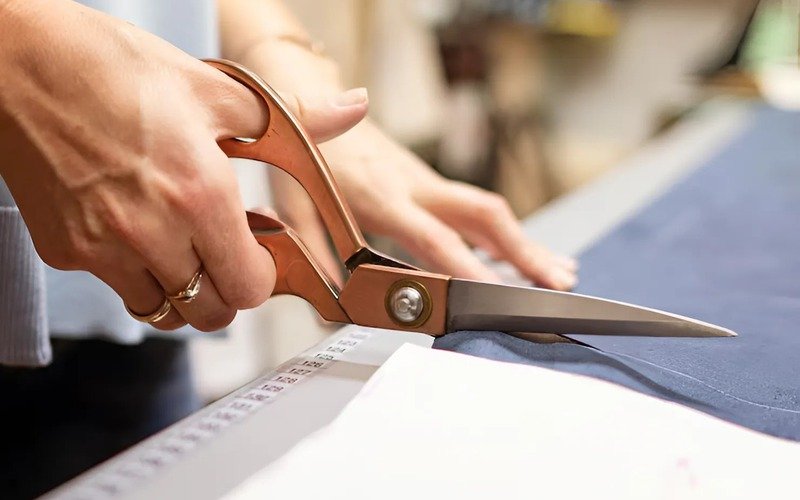
2. The special parts of fabric shears
Fabric shears have special parts that make them so good for fabric. Let’s look at them.
2.1. Super sharp blades
- Material matters: The blades are usually made from very strong steel, often high-carbon steel (a type of steel known for holding a sharp edge). Why? Because this steel can be made very, very sharp and it stays sharp for a long, long time. This means your blade cuts better and you don’t have to sharpen it as often.
- Knife-edge: The edges of the blades are ground to be super fine and sharp, like a good knife. This “knife-edge” helps them slice right through fabric smoothly, instead of chewing it.
- Longer blades: You’ll notice fabric shears often have longer blades. The blade length/size is typically over 6 inches. Longer blades mean you can cut more fabric in one go, making it easier to get long, straight, smooth lines.
2.2. Smart handle design
- Bent handles (offset handles): Many fabric shears have bent handles (also called offset handles). This means the handle for your fingers is higher than the blades. Why is this cool? It lets the bottom blade stay flat on your table or cutting surface while you cut. This stops the fabric from lifting up, so you can see your cutting line better and cut more accurately.
- Different sized finger loops: Look at the finger holes – they are usually different sizes (asymmetrical finger loops – meaning the loops aren’t the same size). One loop is bigger, so you can fit a few fingers in for a strong, comfortable grip and good control. The smaller loop is for your thumb.
2.3. The result
All these special parts – the super sharp high-carbon steel blades, the knife-edge, the long blade length, the bent handles, and comfy finger loops – work together. The result? You get clean cuts every time, no snagging or pulling threads. This makes your work on sewing projects much easier, faster, and your finished items look way more professional thanks to precision cutting (cutting very exactly).
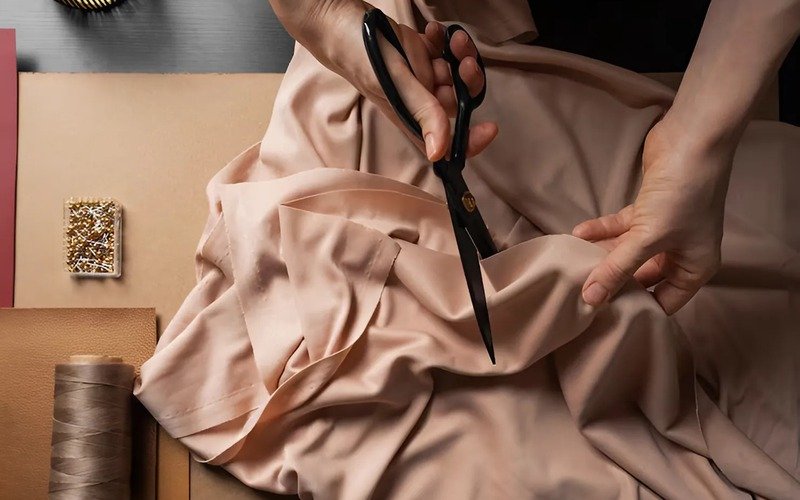
3. Fabric shears vs. regular scissors: what’s the big difference?
It’s important to know how fabric shears are different from the scissors you might use for paper or opening boxes.
3.1. Quick comparison table
| Feature | Fabric Shears | Regular Scissors |
|---|---|---|
| Main use | Cutting fabric types like cotton, silk, denim, sometimes even thin leather. | Paper, string, opening packages, general house tasks. |
| Blades | Very sharp, often long, made of high-carbon steel or good quality stainless steel, special sharp edge for slicing. | Not as sharp, often shorter, basic steel, might crush more than slice. |
| Handles | Often bent handle design, asymmetrical finger loops (different sizes) for good control and keeping fabric flat. | Usually straight handles, same-size finger loops, not made for cutting fabric flat. |
| Cutting action | Smooth slicing, fabric stays flat, very little snagging or messy edges. | Can lift fabric, make it bunch up, or chew the edges; not as neat for fabrics. |
| Cost | Usually cost a bit more because they are special tools made with better materials. | Usually cheaper. |
3.2. Why you can’t just use any scissors for fabric
Using regular scissors for your sewing projects can be frustrating! They can make jagged, uneven edges, pull threads, and sometimes even damage delicate fabrics. It’s much harder to cut accurately. Good results start with good cutting. If the pieces aren’t cut well, it’s harder to sew them together nicely.
Why should I buy fabric shears if I have other scissors? Regular scissors can cause problems like ‘chewed edges’, ‘pulled threads’, or ‘fabric slipping’ when you try to cut fabric with them. Investing in fabric shears makes a big difference to how professional your finished items look.

4. The golden rule: why fabric shears are for fabric only!
This is very important to remember if you want your fabric shears to last and work well.
4.1. Keeping them sharp
This is the most important rule for fabric shears: only use them to cut fabric. Nothing else! The blades of fabric shears are very sharp and precisely made. Cutting things like paper, plastic, tape, or even wire will make them dull very quickly.
What things make fabric shears dull? Why is paper so bad for them? Paper is especially bad because it has tiny, rough bits in it (even if you can’t see them) that act like sandpaper on the sharp edges.
4.2. What happens when they’re dull?
If your fabric shears get dull, they won’t cut fabric nicely anymore. Instead, they might:
- Fold the fabric over instead of cutting through it.
- Chew or fray the fabric edges, making them look messy.
- Snag or pull on threads.
- Make you push really hard, which makes your hand tired and your cuts wobbly.
What happens if I use dull fabric shears on my fabric projects? You’ll struggle with cutting, and your fabric pieces won’t be neat.
4.3. A dedicated tool
Think of your fabric shears as a special tool, just for fabric. Like a chef has special knives just for food, you have special shears just for your fabric projects. They are important sewing tools.
4.4. “Can you use fabric shears on paper effectively?”
Someone might ask, ‘But can they cut paper?’ Yes, they can cut paper, especially when new. But please don’t! Every time you cut paper with your fabric shears, you are making them a little bit worse for cutting fabric.
Keep a different, cheap pair of scissors for paper and other crafts. It ruins them for their main, important job. So, while fabric shears can cut paper effectively, you shouldn’t use them for this purpose if you want to maintain their sharpness for fabric.

5. Common types of fabric shears
There isn’t just one type of fabric shear. Here’s a quick look at a few common ones you might see. These are all types of cutting implements for your sewing kit.
5.1. Dressmaker’s Shears
These are the most popular kind and a great all-around choice. They usually have one pointed tip and one rounded tip, and are good for most sewing projects and cutting many fabric types. These are often what people think of as standard fabric cutting shears. They are a key example of product types: Dressmaker’s Shears.
5.2. Tailor’s Shears
These are usually heavier, stronger, and a bit longer than dressmaker’s shears. They are great for cutting thick fabrics (like heavy wool, denim, or canvas) or several layers of fabric at once.
5.3. Pinking Shears
These are easy to spot because their blades have a zig-zag edge. They are not for cutting out your main pattern pieces. Instead, you use them to finish the edges of fabric inside your project (like seam allowances). The zig-zag cut helps stop the fabric from fraying or unraveling too much.
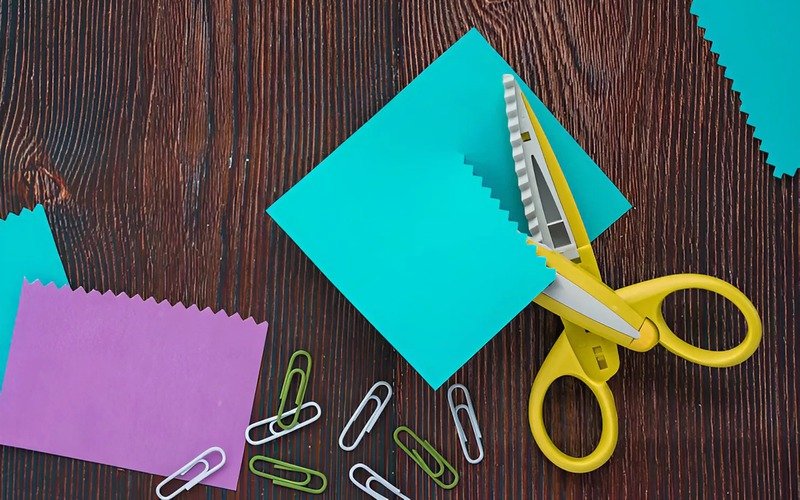
5.4. Embroidery Scissors
These are very small scissors with tiny, sharp, pointed blades. They are not for cutting big pieces of fabric! They are for small, careful jobs like snipping threads close to your sewing, or cutting tiny details for appliqué. Understanding these common types helps you choose the right sewing tools for your needs.

6. How to pick your first pair of fabric shears: simple tips
Okay, so you want to get your first pair of fabric shears. Here are a few simple things to think about.
6.1. Feel the weight and comfort
If you can, try holding a few pairs in a store. They should feel good in your hand – not too heavy so your hand gets tired, but not so light they feel weak. The finger loops should be comfy. How should they feel when I hold them? Comfortable and balanced.
6.2. Check the smoothness
Gently open and close the blades. They should move smoothly and evenly. They shouldn’t stick or feel very loose and wobbly. What should I check about how they open and close? Look for a smooth, easy motion.
6.3. Size
A good size to start with for Dressmaker’s Shears is often around 8 inches long (that’s about 20 cm). This size works well for most sewing projects. Smaller ones are for tiny details, bigger ones for very long cuts, but 8 inches is a good middle choice. What size fabric shears is good for a beginner? Around 8 inches is usually great.
6.4. Don’t go for the cheapest
You don’t need the most expensive pair, especially when starting. But try to avoid the super, super cheap ones. Good shears are made with better blade material (like high-carbon steel) and are built better. This means they cut well and stay sharp longer. Think of it as a good tool that will help you a lot. Is it okay to buy really cheap fabric shears? It’s better to invest a little more for quality that lasts and performs well.
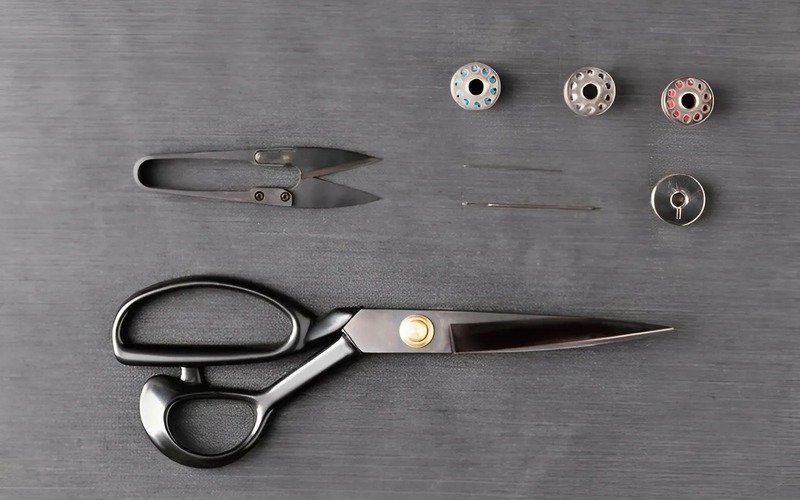
7. Keep your shears happy: basic care
Good fabric shears can last a very long time if you take care of them. Here’s how:
7.1. Fabric only! (yes, again!)
Remember the golden rule: fabric only! This is the best way to keep them sharp.
7.2. Wipe clean
After you finish sewing, use a soft, dry cloth to wipe any lint or tiny fabric bits off the blades. This keeps them clean and working smoothly. How do I clean my fabric shears? Just a quick wipe with a dry cloth.
7.3. Store safely
When you’re not using them, keep your shears safe. Put them in a sheath (a cover for the blades, if they came with one), a special spot in your sewing box, or a drawer where the blades won’t get bumped or damaged. Keep them dry to stop rust, especially if the blades are high-carbon steel. Where should I keep my fabric shears when I’m not using them? In a safe, dry place.
7.4. Sharpening
After a lot of use, even the best shears will get a bit dull and need sharpening. The best way to get good shears sharpened is to take them to a professional. They know how to do it right. Some people sharpen their own, but it’s tricky.
If you do it wrong, you can spoil them. So, for good shears, a pro is usually best. What about sharpening my fabric shears? Professional sharpening is recommended when they become dull. They are an important investment, so treat them well!
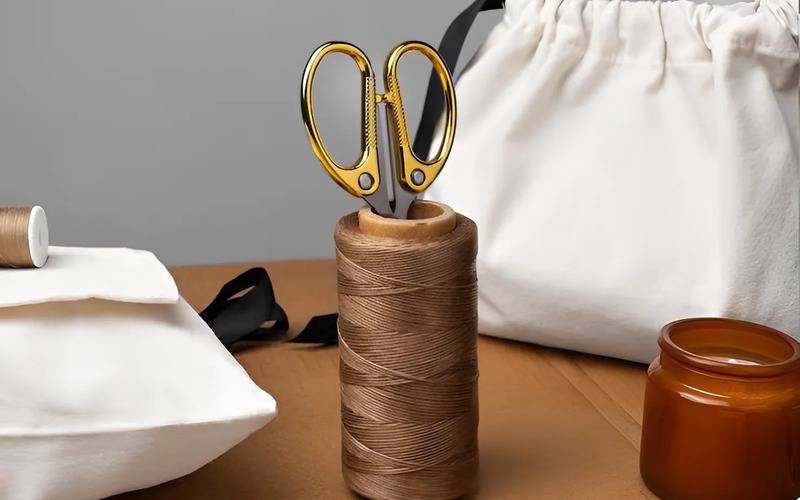
8. Frequently asked questions (FAQs)
Here are some common questions about fabric shears.
8.1. What are fabric shears specifically designed for?
Fabric shears are made just for one thing: cutting fabric! They cut all fabric types (like cotton, silk, or denim) cleanly and smoothly, without messing up the material.
8.2. What’s the main difference between Dressmaker’s shears and Tailor’s shears?
Dressmaker’s shears are good all-around scissors for most sewing. Tailor’s shears are usually stronger and heavier, better for thick fabrics or cutting many layers at once.
8.3. Can I use regular scissors if I’m just starting sewing?
You can try, but regular scissors often make cutting fabric tricky and can make messy edges. Using proper fabric shears, even a basic pair, will make your sewing projects much easier and look better.
8.4. How do I know if my fabric shears are sharp enough?
Sharp shears should cut fabric easily and smoothly, right to the tips. If they catch on threads, fold the fabric, or you have to push hard, they probably need sharpening.
8.5. Are expensive fabric shears always better?
More expensive shears often use better blade material (like high-carbon steel) so they stay sharp longer. But a good mid-price pair is much better than cheap ones and can be great for starting out!
Read more:
So, now you know! Fabric shears are super important sewing tools. They are specially made to cut fabric easily and perfectly. Using good fabric shears makes your sewing projects more fun, helps your finished items look amazing, and stops you from wasting good fabric with bad cuts.
Getting a good pair of fabric shears is a great idea for anyone who loves to sew or work with fabric. They are a key part of your textile craft supplies.
Packlove is your partner for custom labels and tags that are perfect for all the amazing garments and textile products you’ll make with your fabric shears. Packlove also offers wonderful packaging, great for crafters and small businesses who use quality tools like fabric shears to make top-notch items.





















